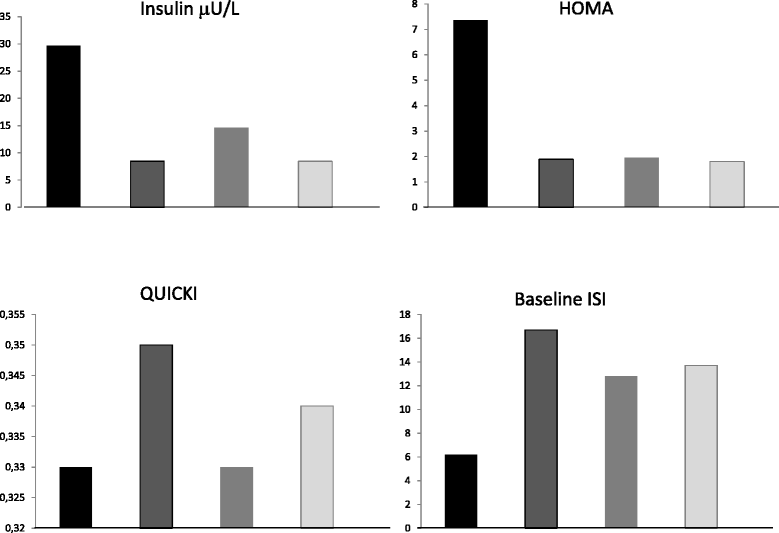Glycogen storage disease type Ia (GSDIa) but not Glycogen storage disease type Ib (GSDIb) is associated to an increased risk of metabolic syndrome: possible role of microsomal glucose 6-phosphate accumulation
- PMID: 26219379
- PMCID: PMC4518509
- DOI: 10.1186/s13023-015-0301-2
Glycogen storage disease type Ia (GSDIa) but not Glycogen storage disease type Ib (GSDIb) is associated to an increased risk of metabolic syndrome: possible role of microsomal glucose 6-phosphate accumulation
Abstract
Background: In GSDIa, glucose 6-phosphate (G6P) accumulates in the endoplasmic reticulum (ER); in GSDIb, G6P levels are reduced in ER. G6P availability directly modulates the activity of 11β-hydroxysteroid dehydrogenase type 1 (11βHSD1), an ER-bound enzyme playing a key role in the development of the metabolic syndrome (MS).
Objective: To evaluate the prevalence of MS and Insulin Resistance (IR) in GSDIa and GSDIb patients.
Patients and methods: This was a prospective study. All the enrolled patients were followed at the Department of Pediatrics "Federico II" University of Naples for 10 years. Clinical and biochemical parameters of MS and the presence of IR were recorded. The results were correlated with the biochemical parameters of GSDI-related metabolic control. 10 GSDIa patient (median age 12.10 ± 1.50), 7 GSDIb patients (median age 14.90 ± 2.20 were enrolled in the study. They were compared to 20 and 14 age and sex matched controls, respectively. 10 GSDIa patients (median age 24.60 ± 1.50) and 6 GSDIb patients (median age 25.10 ± 2.00) completed the 10-year-follow-up. At the end of the study the patients' data were compared to 10 and 6 age and sex matched controls, respectively.
Results: At study entry, 20 % GSDIa patients had MS and 80 % showed 2 criteria for MS. GSDIa patients showed higher HOMA-IR than controls and GSDIb patients (p < 0.001, p < 0.05), respectively. Baseline ISI was lower in GSDIa than controls (p < 0.001). QUICKI was significantly lower in GSDIa than in controls (p < 0.001). At the end of the study 70 % of GSDIa patients had MS and 30 % showed 2 criteria for MS. HOMA-IR was higher in GSDIa than controls (p < 0.01). Baseline ISI was higher in GSDIb than controls (p < 0.005) and GSD1a (p < 0.05). QUICKI was lower in GSD1a patients than in controls (p < 0.03). VAI was higher in GSDIa patients than controls (p < 0.001) and GSDIb patients (p = 0.002).
Conclusions: Our data showed high prevalence of IR and MS in GSDIa patients. We speculate a possible role of 11βHSD1 modulation by G6P availability. We suggest a routine metabolic assessment in GSDIa patients.
Figures



References
-
- Paterson JM, Morton NM, Fievet C, Kenyon CJ, Holmes MC, Staels B, Seckl JR, Mullins JJ. Metabolic syndrome without obesity: Hepatic overexpression of 11beta-hydroxysteroid dehydrogenase type 1 in transgenic mice. Proc Natl Acad Sci U S A. 2004;101(18):7088–93. doi: 10.1073/pnas.0305524101. - DOI - PMC - PubMed
-
- Kotelevtsev Y, Holmes MC, Burchell A, Houston PM, Schmoll D, Jamieson P, Best R, Brown R, Edwards CR, Seckl JR, Mullins JJ. 11beta-hydroxysteroid dehydrogenase type 1 knockout mice show attenuated glucocorticoid-inducible responses and resist hyperglycemia on obesity or stress. Proc Natl Acad Sci U S A. 1997;94:14924–9. doi: 10.1073/pnas.94.26.14924. - DOI - PMC - PubMed
MeSH terms
Substances
Supplementary concepts
LinkOut - more resources
Full Text Sources
Other Literature Sources
Medical

